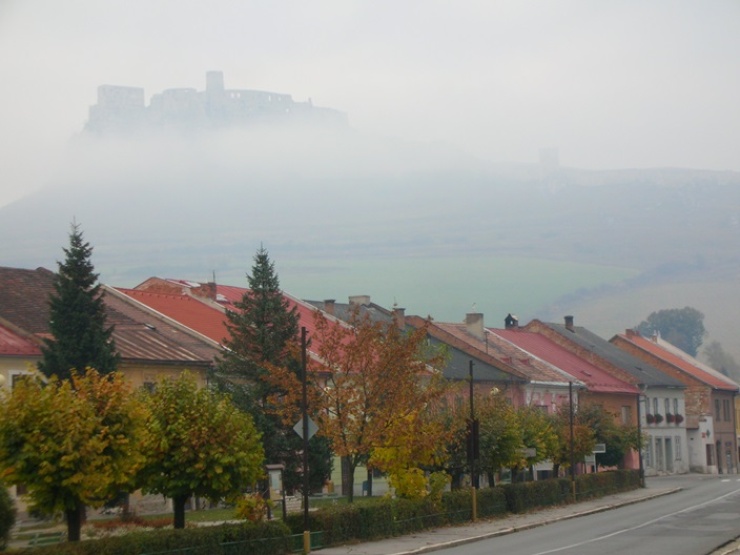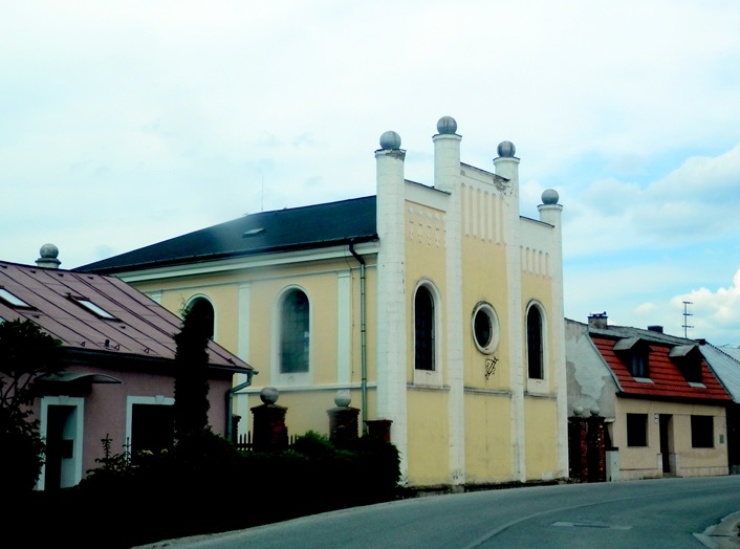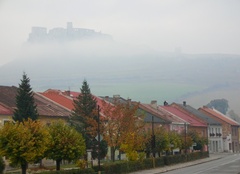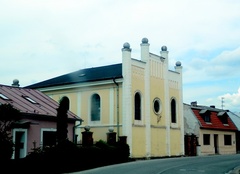Spisske Podhradie
Pronounced “SPEESH-skeh Pohd-HRAHD-ee-eh” (Hungarian: Szepesváralja, German: Kirchdrauf or Kirchdorf, Polish: Spiskie Podgrodzie)
The first known Jewish settlers arrived in the village of Spišské Podhradie in the 1840s after longstanding restrictions on where Jews could live were finally lifted. Jews joined the multicultural population of ethnic Germans, Hungarians and Slovaks who inhabited the area then under the control of the Kingdom of Hungary. Most Jewish residents earned a living as the owners of small businesses. Some also worked as artisans.
In the 1840s the Jewish community of Spišské Podhradie grew to include a Chevra Kaddisha (burial society) and Jewish cemetery, followed by a mikvah (ritual bath) and Talmud Torah (Jewish elementary school) in the 1870s. The town’s synagogue was built in 1872 in the Moorish Revival style that adopted architectural elements from the Muslim world. Although some Jewish communities in Hungary began to adopt more Liberal practices, the Jewish community of Spišské Podhradie maintained traditional Orthodox traditions.
By 1900 the Jewish population of Spišské Podhradie had grown to about 295 people, making up roughly 10 percent of the town’s total population. A number of Jewish organizations were active in the life of the community, including various charities and a yeshiva (religious high school). In 1905, the synagogue burned down and was rebuilt in a more classical style of architecture.
After World War I (1914-1918), Spišské Podhradie became part of the new state of Czechoslovakia. Survivor Sam Kane was born in 1919, one of 12 children born to his traditional Jewish parents who owned a small grocery store in the town. In the 1920s and 1930s the approximately 400 Jews of Spišské Podhradie made up roughly 14 percent of the total population. Throughout this time the traditional Jewish community saw more and more of its members rally to the cause of Zionism, a movement that sought an independent Jewish state.
After Nazi Germany annexed Austria and portions of Czech territory in 1938, Kane remembered hearing the news of anti-Jewish legislation in disbelief. He later said, “We were very naïve because we had grown up in a democracy under Czechoslovakia.” The next year German forces invaded Czechoslovakia and Slovakia became a puppet state of Nazi Germany. Jewish children were expelled from public schools and Jewish-owned businesses were closed, including the grocery store owned by Kane’s parents. A number of Jewish men were recruited into backbreaking forced labor.
In March 1942, Kane’s sisters were among the 16- to 22-year-old women rounded up and sent to a collection camp before being deported to the killing center of Auschwitz-Birkenau. Deportations continued through the fall, when only about 40 Jews remained in the town. The few who remained were deported when German forces occupied Spišské Podhradie in September 1944.
Although some 40 Jewish survivors returned to Spišské Podhradie after the Holocaust, most emigrated to other countries after the Communist takeover of Czechoslovakia in 1948. In 1995, the building of the local synagogue was reopened as a museum. Today no Jews live in the town.
Spisske Podhradie: Photographs & Artifacts
-
 The town of Spišské Podhradie is situated at the bottom of the hill of the Spiš Castle which was built in the 1100s. This photo was taken in October 2006. Credit: Wikimedia Commons/ Keith Page / CC-BY-SA 2.0
The town of Spišské Podhradie is situated at the bottom of the hill of the Spiš Castle which was built in the 1100s. This photo was taken in October 2006. Credit: Wikimedia Commons/ Keith Page / CC-BY-SA 2.0 -
 The former synagogue in Spišské Podhradie, May 2016. Credit: WIkimedia Commons / Ing.Mgr.Jozef Kotulič / CC-BY-SA 4.0
The former synagogue in Spišské Podhradie, May 2016. Credit: WIkimedia Commons / Ing.Mgr.Jozef Kotulič / CC-BY-SA 4.0
Destroyed Communities Memorial Slope
Spisske Podhradie: Survivors
We were very naïve because we had grown up in a democracy under Czechoslovakia. I asked a question, ‘Where’s the police?’

